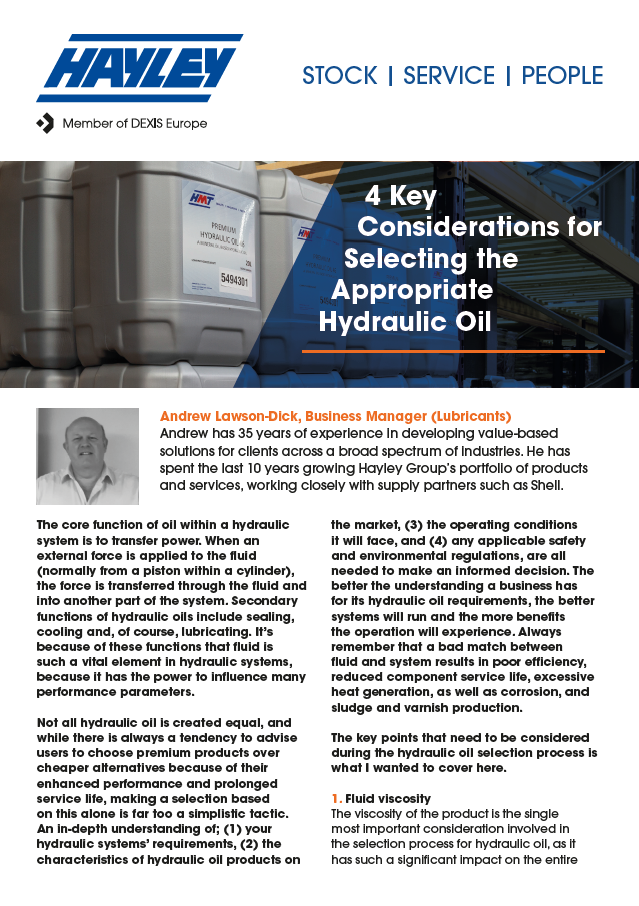Andrew Lawson-Dick, Business Manager (Lubricants)
Andrew has 35 years of experience in developing value-based solutions for clients across a broad spectrum of industries. He has spent the last 10 years growing Hayley Group’s portfolio of products and services, working closely with supply partners such as Shell.
The core function of oil within a hydraulic system is to transfer power. When an external force is applied to the fluid (normally from a piston within a cylinder), the force is transferred through the fluid and into another part of the system. Secondary functions of hydraulic oils include sealing, cooling and, of course, lubricating. It’s because of these functions that fluid is such a vital element in hydraulic systems, because it has the power to influence many performance parameters.
Not all hydraulic oil is created equal, and while there is always a tendency to advise users to choose premium products over cheaper alternatives because of their enhanced performance and prolonged service life, making a selection based on this alone is far too a simplistic tactic.
An in-depth understanding of; (1) your hydraulic systems’ requirements, (2) the characteristics of hydraulic oil products on the market, (3) the operating conditions it will face, and (4) any applicable safety and environmental regulations, are all needed to make an informed decision. The better the understanding a business has for its hydraulic oil requirements, the better systems will run and the more benefits the operation will experience. Always remember that a bad match between fluid and system results in poor efficiency, reduced component service life, excessive heat generation, as well as corrosion, and sludge and varnish production.
The key points that need to be considered during the hydraulic oil selection process is what I wanted to cover here.
1. Fluid viscosity
The viscosity of the product is the single most important consideration involved in the selection process for hydraulic oil, as it has such a significant impact on the entire system’s operation. If the fluid is too thick (high viscosity), the fluid becomes more difficult to move through the system, resulting in sluggish movement that reduces mechanical efficiency and generates energy losses. If fluid viscosity is too high, unnecessary heat generation also can cause issues. If the fluid’s viscosity is too low, the oil is thin, and this can lead to flow leakage and wear damage. The latter happening due to the increased risk of metal-to-metal contact that comes with low viscosity hydraulic fluid.
Requirements for oil viscosity are determined by the systems’ load and the range of operating temperatures that the system is exposed to, so it’s important to match these values up when determining the best hydraulic oil for your needs.
2. Anti-wear
A fluids’ anti-wear properties are influenced by the additives used in its composition. Wear is dangerous for components in a hydraulic system as it directly affects their service life, increasing the risk of failure and, with it, the chance of costly periods of downtime impacting both productivity and revenue.
Additives such as zinc dithiophosphate (ZDDP) are commonly used for wear-prevention, forming a film or protective oil between moving metal parts. One issue with ZDDPs is that they are deemed to be toxic to aquatic wildlife and are not readily biodegradable, meaning that they are unsuitable for certain applications where metal content in wastewater must be minimised and environmental release controls are strict. Ashless (zinc-free) alternatives are available for environmentally-sensitive applications and increase options for an easier disposal.
It’s important to point-out that no anti-wear hydraulic oil is capable of preventing wear in a hydraulic system that is suffering due to poor design or incorrectly selected components.
3. Anti-oxidation
While components of a hydraulic system such as vane and gear pumps need wear protection, other types of pumping equipment (e.g. piston pumps) have a greater need for protection against rust and oxidation. When two or more types of pumps are used in a system, a hydraulic oil that fulfils the requirements of all pumps to a satisfactory standard should be chosen.
The oxidation of hydraulic oil alters its structure and properties, replacing molecules with chemicals like acids, ketones and aldehydes, decreasing the stability of the fluid as a result. An oxidised oil is often characterised by a darkening in colour, a smell often likened to burning and the forming of sludge deposits. It’s bi-products of oxidation like sludge and varnish that can decrease mechanical efficiency within the hydraulic system and cause premature wear to parts, especially those containing soft metals.
4. Anti-foaming
In hydraulic oil there are two types of foam that generally occur; surface foam and entrained air. When foam is carried by hydraulic fluid, system performance is negatively affected.
Surface foaming is often caused by air entering the hydraulic system through the reservoir or through leakage points. Effective reservoir design, regular leak monitoring and the use of defoaming additives are normally able to eliminate the problem.
By not selecting appropriate base oils and additives for your hydraulic fluids, entrained air can become a more serious problem for the reliability and longevity of your system. This is because the entrained air is drawn into the system, causing cavitation, a hammering action that can result in parts being destroyed.
A balancing act is called for when it comes to using anti-foam additives, as these detergents effectively tackle surface foam but, in high concentration, they can also increase entrained air. Viscosity of your fluid can also have a bearing on the chance of foaming affecting your hydraulic system, as bubbles will take longer to migrate through a more viscous fluid.
There are plenty of variables that will affect your selection of an appropriate hydraulic oil. The viscosity and composition of the fluid, especially it’s additives, determine its ability to handle temperature extremes, prevent damaging wear, oxidation and foaming, and maintain a good level of efficiency in the system. The aim will always be to prolong the service life of both your hydraulic oil and the components within the wider hydraulic system, and to do this, matching system requirements, fluid parameters and any external/environmental considerations is vital.
Speak to your local branch today about any of your hydraulic oil requirements. You can find their details by using our online Branch Finder tool.




